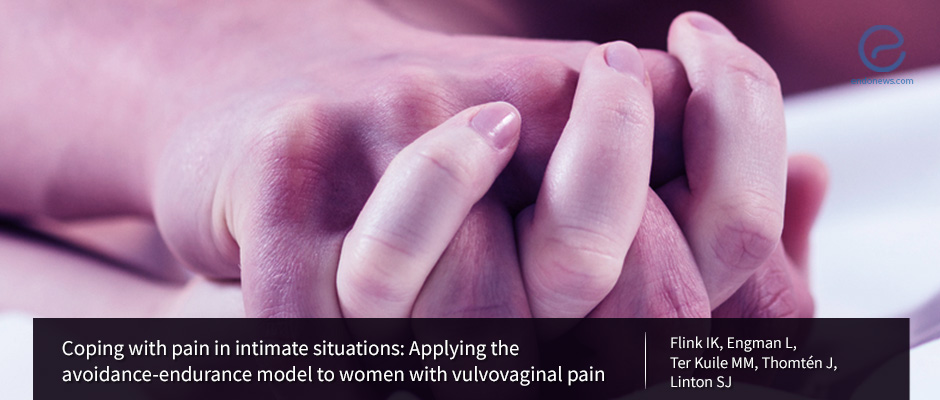Coping with vulvovaginal pain in intimate situations
Jun 8, 2018
When catastrophizing is associated with avoidance behavior, it may lead to an increase in vulvovaginal pain over time.
Key Points
Highlights
- Avoidance and endurance coping behaviors are possible mediators of the relation between catastrophizing and long-term pain in women experiencing vulvovaginal pain.
- Avoidance strategies involve avoiding sexual activity due to pain catastrophizing, whereas endurance strategies involve enduring sexual activity due to catastrophizing around events surrounding the pain (e.g. losing their partner).
Importance
- Understanding coping mechanisms used by women with chronic vulvovaginal pain can guide treatment for the management of pain.
- Longitudinal studies exploring the coping mechanisms that mediate the relation between catastrophizing and long-term pain are lacking.
Key Results
- Avoidance was found to be a significant mediator of the relationship between catastrophizing and vulvovaginal pain over time. In contrast, endurance was not found to be a significant mediator longitudinally.
- The authors propose graded exposure in vivo as treatment, which focuses on reducing excessive avoidance behavior through gradual confrontation to the feared (sexual) stimuli.
What’s Done Here
- Avoidance and endurance coping behaviors were investigated as possible mediators of the relation between catastrophizing and long-term pain in women experiencing vulvovaginal pain.
- Women between the ages of 18 and 35 years, with vulvovaginal pain, provided demographic data and completed surveys on avoidance and endurance coping behaviors, pain, and pain catastrophizing.
Limitations of the Study
- Participants were analyzed across five months, a relatively short time-frame.
- An exact response rate could not be determined as data on how women were invited to participate was lacking.
- As the measure used for assessing avoidance and endurance is relatively new, its psychometric robustness was questionable.
Lay Summary
Chronic vulvovaginal pain has a serious impact on women’s lives, affecting daily activities including sexual activities. Avoiding sexual activity has been shown to be a central coping strategy in other pain populations and has also been seen in women with vulvovaginal pain, but there is limited support for the impact over time. Avoidance behavior is important as it mediates the link between pain catastrophizing and pain-related outcomes.
An alternative coping strategy for women with vulvovaginal pain considers endurance: instead of avoiding pain, women may endure sexual activities because they catastrophize around events surrounding the pain (e.g. losing their partner). Therefore, endurance behavior may be a possible mediator of the relationship between catastrophizing and pain-related outcomes. This study explored whether avoidance and/or endurance of sexual activities, when triggered by catastrophizing, might influence vulvovaginal pain over time.
In a recent article by Flink et al., entitled "Coping with pain in intimate situations: Applying the avoidance-endurance model to women with vulvovaginal pain", women between the ages of 18 and 35 years were recruited from two universities in Sweden. Participants completed surveys about age, health care consumption, relationship status, and children. Avoidance and endurance coping behaviors were measured through the CHAMP Sexual Pain Coping Scale (CSPCS), the pain was measured using the Female Sexual Function Index (FSFI), and pain catastrophizing was measured using the Pain Catastrophizing Scale (PCS). The authors used statistical analysis to analyze the data.
Avoidance was found to be a significant mediator of the relationship between catastrophizing and vulvovaginal pain over time. In contrast, endurance was not found to be a significant mediator over time, however, was significant in the cross-sectional analysis. This shows that although endurance may be maladaptive, it does not have the same impact on pain as avoidance.
These findings were found to be consistent with the literature, which shows avoidance as being a salient risk factor for persistent pain in other pain problems. The findings support catastrophizing and avoidance behavior as being central factors also in women with vulvovaginal pain. More specifically, when catastrophizing is associated with avoidance behavior, this may lead to an increase in pain over time.
The authors propose graded exposure in vivo as treatment, which focuses on reducing excessive avoidance behavior through gradual confrontation to the feared (sexual) stimuli, which has generated positive results in women with women with lifelong vaginismus. They also recommend further research to explore coping mechanisms in women with vulvovaginal pain.
Research Source: https://www.ncbi.nlm.nih.gov/pubmed/?term=28927649
pain coping avoidance endurance vulvovaginal sex relation intimate catastrophizing fear vaginismus CHAMP CSPCS FSFI

